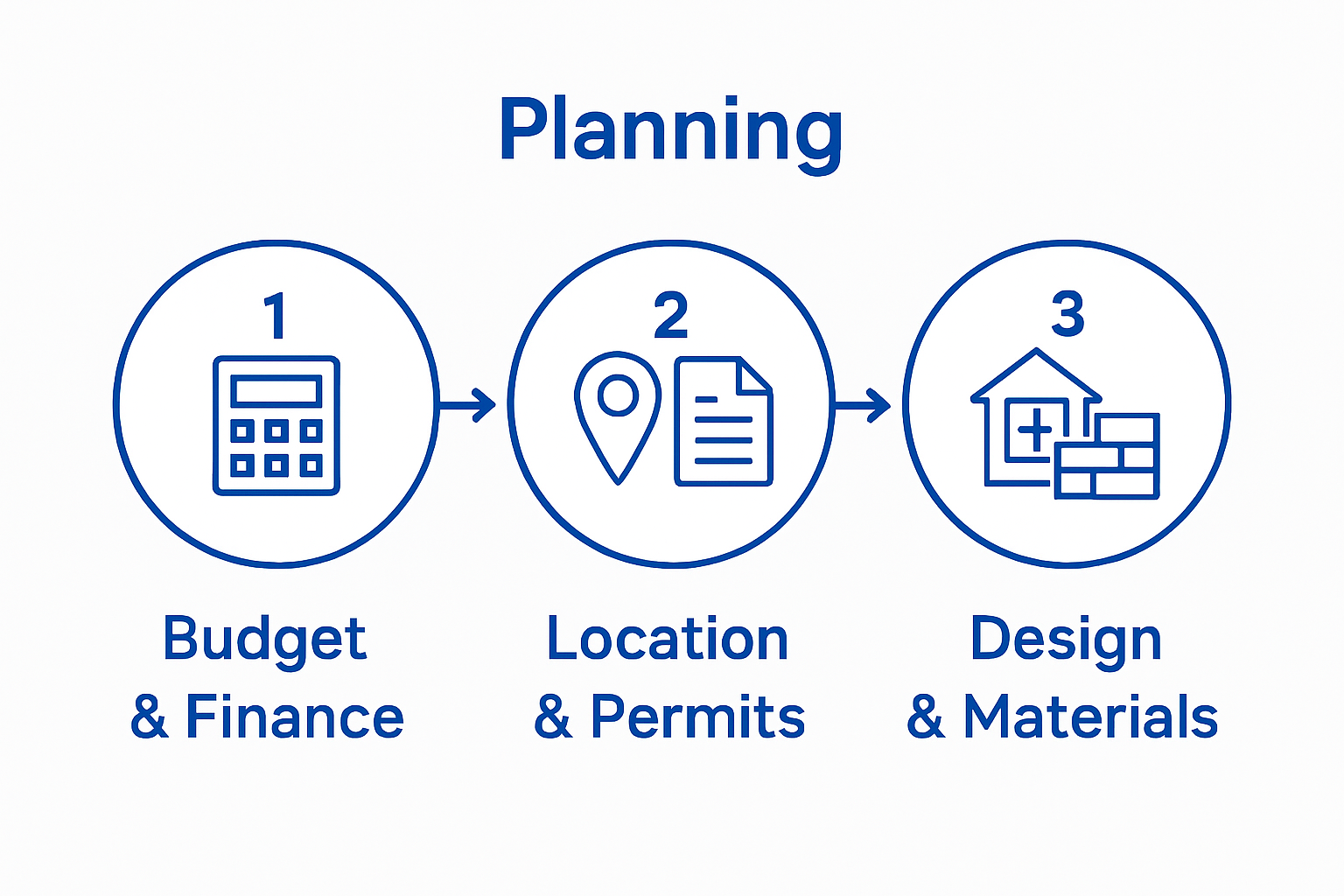- Bina Rumah Batu-Bata
- Zero Deposit
- Spesifikasi Rumah
- Lokasi Projek
- Pembiayaan LPPSA
- Garis Panduan LPPSA (Rasmi)
- Soalan Lazim LPPSA
- E-Book LPPSA (Download)
- 1. Apa itu LPPSA?
- 2. Kelebihan LPPSA
- 3. Syarat Kelayakan
- 4. Jenis-Jenis Pembiayaan
- Jenis 1 – Pembelian Rumah Kediaman Yang Telah Siap
- Jenis 2 – Membina Rumah Di Atas Tanah Sendiri
- Jenis 3 – Membeli Rumah Kediaman Yang Sedang Dibina
- Jenis 4 – Pembelian Tanah Bagi Pembinaan Rumah
- Jenis 5 – Melunaskan Keseluruhan/ Sebahagian Pinjaman Sedia Ada Daripada Bank/ Institusi Kewangan
- Jenis 6 – Pembinaan Rumah Kediaman Di Atas Tanah Yang Sedang Dibiayai Oleh BPP/ LPPSA
- Jenis 7 – Ubah Suai Rumah Yang Sedang Atau Telah Selesai Bayar Melalui LPPSA
- 5. Semak Kelayakan LPPSA
- 6. Dokumen Yang Diperlukan
- 7. Insurans/ Takaful LPPSA
- 8. Kos Yuran Guaman
- 9. BONUS: Bina Rumah
- Pembiayaan Koperasi
- Pengeluaran KWSP
- Bayaran Tunai
- Kalkulator
How to Build a House Yourself: A Complete DIY Guide | RumahHQ

Building your own home in Malaysia sounds like an ambitious dream and for many, it is a journey packed with surprises at every turn. You might expect costs to be straightforward but brace yourself. Total construction expenses can swing wildly from RM250,000 up to RM650,000 depending on land, size, and complexity. Most people think the trickiest part is design or bricklaying but in reality, it is the financial planning and permit wrangling that challenge even seasoned homeowners.
Table of Contents
Quick Summary
| Key Point | Explanation |
|---|---|
| 1. Establish a Realistic Budget | Calculate total costs including land, materials, and unexpected expenses, ensuring financial feasibility before starting construction. |
| 2. Select the Right Location | Carefully evaluate land characteristics, including soil stability and environmental constraints, to ensure suitability for construction. |
| 3. Obtain Necessary Permits | Gather required documentation and approvals from local authorities to ensure compliance with building regulations before commencing work. |
| 4. Use Quality Materials | Source reliable and durable construction materials, considering local climates and sustainability for long-lasting results. |
| 5. Prepare for Final Inspections | Document all construction phases and perform thorough evaluations to address any issues before moving into your new home. |
Step 1: Determine Your Budget and Financing Options
Building a house yourself requires strategic financial planning and a crystal clear understanding of your monetary capabilities. Before breaking ground, you must develop a comprehensive budget that encompasses every potential expense while identifying sustainable financing pathways.
Establishing a realistic budget demands meticulous assessment of your current financial landscape. Begin by calculating your total available funds, including savings, potential loans, and any government assistance programmes. Total project costs can range between RM250,000 to RM650,000 depending on land location, house size, and construction complexity. Malaysian homeowners often leverage multiple financing sources, including personal savings, bank loans, and specialised housing programmes.
Learn more about construction financing options through detailed consultations with financial advisors who understand local housing regulations. These professionals can help you navigate intricate loan structures and identify the most suitable financing approach for your specific circumstances.
Your financial strategy should include several critical components. Calculate anticipated expenses by breaking down costs into categories such as land acquisition, materials, labour, permits, and unexpected contingencies. Most experts recommend allocating an additional 10 to 15 percent of your total budget for unforeseen expenses. This buffer protects you from potential financial strain during the construction process.
Consider exploring government-supported financing programmes tailored for Malaysian homeowners. Options like LPPSA, KWSP withdrawals, and specific housing schemes can provide significant financial support. These programmes often offer more flexible terms and lower interest rates compared to traditional bank loans, making home construction more accessible.
Verify your budget’s feasibility by creating a detailed spreadsheet documenting every anticipated expense. Include precise line items for materials, labour costs, legal fees, and administrative expenses. Cross reference your estimated budget with quotes from multiple contractors to ensure accuracy and identify potential cost-saving opportunities. A well-researched and meticulously planned budget becomes your financial roadmap, guiding you confidently through the home construction journey.

Step 2: Select a Suitable Location and Obtain Permits
Selecting the right location for your home construction is a critical decision that impacts everything from structural design to long term property value. Your chosen site will determine not just your home’s aesthetics but also its structural integrity, legal compliance, and future potential.
Land selection requires comprehensive evaluation beyond mere visual appeal. Investigate geological characteristics thoroughly, examining soil composition, drainage patterns, and potential environmental constraints. Malaysian terrain varies significantly between urban and rural regions, with each presenting unique challenges. Selangor and Kuala Lumpur areas, for instance, demand particular attention to soil stability and flood risk assessment.
Explore detailed land selection strategies to understand nuanced considerations. Engage professional land surveyors who can provide precise topographical studies and identify potential building restrictions. They will help you understand critical factors like land gradient, underground water tables, and potential geological instabilities that could compromise your construction.
Permit acquisition represents another crucial component of this process. Malaysian local authorities require multiple documentation and approvals before commencing construction. Mandatory permits include Development Order (Pelan Rekabentuk), Building Plan Approval (Kelulusan Pelan Bangunan), and relevant local municipal council permissions. Each district within Selangor and Kuala Lumpur might have slightly different regulatory requirements, so thorough research becomes paramount.
Prepare a comprehensive documentation package including detailed site plans, architectural drawings, land ownership certificates, and environmental impact assessments. Collaborate with registered architects and legal professionals who understand local regulatory landscapes. They can streamline the permit application process, anticipate potential challenges, and ensure your documentation meets all municipal standards.
Verify your location’s suitability by conducting rigorous site assessments. This includes checking utility accessibility, road connectivity, proximity to essential services, and potential future development plans in the surrounding area. A strategically chosen location not only facilitates smoother construction but also enhances your property’s long-term value and livability.
Step 3: Design Your House and Gather Necessary Materials
Designing your house represents the transformative moment where your construction vision transitions from abstract concept to tangible blueprint. This critical stage demands careful planning, creative thinking, and pragmatic decision making that balances aesthetic preferences with structural practicality.
Malaysian residential designs require thoughtful consideration of tropical climate conditions, incorporating features like strategic ventilation, robust roof structures, and materials resistant to high humidity and intense sunlight. Collaborate with an experienced architect who understands local building regulations and can translate your vision into a structurally sound design that meets both personal preferences and municipal requirements.
Explore comprehensive home design consultation strategies to refine your architectural approach. Your design should prioritize functional living spaces, efficient room layouts, and potential future adaptability. Consider elements like natural light penetration, cross-ventilation, and sustainable material selections that enhance both comfort and energy efficiency.
Material procurement demands meticulous research and strategic sourcing. Recommended primary construction materials include reinforced concrete, clay bricks, steel reinforcements, and locally sourced timber. Visit multiple suppliers, compare quality and pricing, and obtain detailed quotations. Develop relationships with reputable building material vendors who can provide consistent quality and potentially offer volume discounts.
Create a comprehensive materials inventory spreadsheet documenting exact quantities, specifications, and estimated costs. This document becomes your procurement roadmap, helping track expenses and preventing unnecessary wastage. Factor in potential price fluctuations and include a contingency budget of 10 to 15 percent to accommodate unexpected material cost variations.
Verify your design and material selection by conducting multiple review sessions. Engage professional architects, structural engineers, and experienced contractors to evaluate your plans. Their expert insights can identify potential design limitations, suggest cost-effective alternatives, and ensure your vision aligns with practical construction requirements. A well-conceived design coupled with carefully selected materials sets the foundation for a successful home building journey.
Below is a summary table of recommended materials for house construction in Malaysia, detailing their typical use and key advantages.
| Material | Primary Use | Key Advantages |
|---|---|---|
| Reinforced concrete | Structural elements | High durability, strong load-bearing |
| Clay bricks | Walls | Good thermal insulation, long-lasting |
| Steel reinforcements | Structure support | Adds strength, resists corrosion |
| Locally sourced timber | Framing, finishes | Sustainable, aesthetic appeal |
| Pressure-treated lumber | Framing, trusses | Moisture and pest resistant |
| PVC pipes | Plumbing | Corrosion resistant, lightweight |
| Copper piping | Plumbing | Withstands high pressure, long life |
Step 4: Lay the Foundation and Structure the Frame
Layering the foundation and constructing the home’s frame represents the most structurally critical phase of your construction journey. This stage transforms your architectural blueprints into a tangible three-dimensional structure, demanding precision, technical expertise, and meticulous attention to detail.
Foundation preparation requires comprehensive geological assessment and strategic engineering. Malaysian terrain presents unique challenges, with varied soil compositions demanding specialized foundation techniques. Conduct thorough soil testing to determine appropriate foundation type, whether slab-on-grade, pier and beam, or deep foundation systems suited to your specific geographical location.
Learn about robust foundation techniques that guarantee long-term structural integrity. Excavate the designated area precisely, removing organic matter and creating a level surface. Implement robust drainage systems to prevent water accumulation, which can compromise foundation stability during monsoon seasons.
Framing represents the skeletal structure defining your home’s shape and spatial configuration. Recommended framing materials include treated timber and steel reinforcements, selected based on load-bearing requirements and environmental conditions. Utilize high-quality pressure-treated lumber resistant to moisture and tropical climate challenges. Ensure accurate measurements, maintaining strict alignment and perpendicularity during wall and roof truss installations.
Precision becomes paramount during this construction phase. Use advanced measuring tools like laser levels and digital measuring devices to guarantee absolute accuracy. Create detailed markings indicating electrical conduit locations, plumbing pathways, and structural support points. Professional-grade framing requires systematic approach, with each structural element meticulously positioned and secured.
Verify your foundation and frame’s quality through rigorous inspection processes. Engage structural engineers to conduct comprehensive assessments, checking for alignment, load-bearing capacity, and compliance with local building regulations. Document each construction stage with detailed photographs and measurements, creating a comprehensive record of your home’s foundational development. A well-executed foundation and frame establishes the cornerstone of your future home, promising durability and structural resilience for decades to come.
Step 5: Install Utilities and Complete Interior Work
Installing utilities and executing interior work represents the transformative phase where your house transitions from a structural shell to a functional living space. This intricate stage demands precision, technical expertise, and a comprehensive understanding of interconnected systems that form the home’s operational infrastructure.
Malaysian residential utility installations require careful navigation of local building codes and technological specifications. Electrical, plumbing, and HVAC systems must be strategically planned to ensure optimal performance, energy efficiency, and long-term reliability. Engage licensed professionals who understand regional technical standards and can implement sophisticated installation techniques tailored to tropical environmental conditions.
Explore comprehensive utility installation strategies to guarantee seamless integration of essential home systems. Begin with electrical infrastructure, mapping out comprehensive wiring routes that accommodate current technological requirements and potential future upgrades. Install robust circuit breakers, implement earthing systems, and ensure adequate load capacity to support modern residential electrical demands.
Plumbing installations demand meticulous attention to water pressure, drainage efficiency, and moisture resistance. Select high-quality PVC and copper piping designed to withstand Malaysia’s humid climate. Implement sophisticated drainage solutions that prevent water accumulation and potential structural damage. Consider integrating water filtration systems and efficient water heating technologies that balance performance with energy conservation.
Interior work encompasses more than aesthetic considerations. Focus on creating functional living spaces that balance comfort, practicality, and design elegance. Install drywall with precision, ensuring smooth surfaces and proper insulation. Select interior finishes that complement your architectural design while providing durability against tropical humidity. Consider sound-proofing techniques, thermal insulation, and ventilation strategies that enhance overall living comfort.
Verify utility and interior installations through rigorous professional inspections. Obtain necessary certifications from local authorities, documenting each system’s compliance with municipal building regulations. Conduct comprehensive testing of electrical circuits, water systems, and structural integrations. A meticulously executed utility and interior installation transforms your construction project from a mere structure into a sophisticated, functional home ready to provide comfort and reliability for years to come.

Step 6: Conduct Final Inspections and Move In
The final inspection and move-in phase represents the culmination of your extensive home construction journey, transforming years of planning and hard work into a tangible living space. This critical stage ensures your newly constructed home meets all safety, structural, and regulatory standards before you officially take residence.
Malaysian building regulations mandate comprehensive final inspections by authorized municipal authorities, requiring a systematic evaluation of every aspect of your home’s construction. Engage professional inspectors who will meticulously assess structural integrity, utility installations, electrical systems, plumbing configurations, and compliance with local building codes. These experts will provide official certification verifying your home’s readiness for occupancy.
Prepare comprehensively for the final inspection by assembling a detailed documentation portfolio. Compile all construction permits, architectural drawings, utility connection certificates, and progressive inspection reports. Conduct a thorough personal walkthrough, documenting any potential issues or areas requiring minor adjustments. Your documentation becomes crucial evidence demonstrating the quality and regulatory compliance of your construction project.
Beyond official inspections, perform your own rigorous assessment of the property. Test all electrical outlets, verify water pressure in different fixtures, check window and door alignments, and assess overall structural soundness. Pay particular attention to potential moisture penetration points, ensuring your home remains resilient against Malaysia’s tropical climate challenges.
Prepare a comprehensive snagging list identifying any minor imperfections or areas requiring refinement. Address these details systematically before final move-in, working closely with your construction team to resolve any outstanding concerns. This meticulous approach guarantees a smooth transition into your newly constructed home.
The following checklist table outlines critical verification steps before final move-in, helping ensure your home meets all safety, regulatory, and quality requirements in Malaysia.
| Verification Step | Purpose | Who Should Perform |
|---|---|---|
| Assemble documentation portfolio | Proof of compliance and approvals | Homeowner |
| Structural integrity inspection | Ensure safety and stability | Professional inspector |
| Utilities testing (water, electric) | Check function and safety of installations | Certified technician |
| Check window and door alignment | Confirm proper installation and sealing | Homeowner/contractor |
| Moisture penetration assessment | Prevent long-term climate-related issues | Inspector/homeowner |
| Compile snagging list | Identify minor defects and imperfections | Homeowner |
| Obtain occupation permit | Legal permission to move in | Homeowner/local council |
Verify your home’s readiness through a structured checklist encompassing structural, utility, and aesthetic considerations. Obtain all necessary occupation permits from local authorities, ensuring legal compliance. Celebrate this momentous achievement knowing you have successfully navigated the complex journey of self-managed home construction, creating a personalized living space that reflects your vision, investment, and commitment to quality.
Build Your Dream Home With Confidence – The Support You Need Is Here
Are you feeling overwhelmed by the complex steps of self-building a house, from budgeting and financing right through to approvals and technical details? Many aspiring homeowners in Malaysia run into challenges such as preparing realistic budgets, navigating legal permits, selecting reliable materials and finding the right professional help. This journey, while rewarding, often brings stress about hidden costs, regulatory obstacles and fears over quality and timelines. If you want absolute peace of mind and professional guidance throughout, RumahHQ is here to bridge those gaps.

Turn your house-building vision into reality with our all-in-one solutions. We offer transparent construction financing consultations, fixed-price packages, certified planning and legal approval support, as well as expert project management. Whether you need help with permits, budget planning or design, get started today at RumahHQ to avoid costly delays and construction pitfalls. Let our trusted team get your project off the ground now – book your free consultation and create your dream home with the certainty you deserve.
Frequently Asked Questions
What is the first step in building a house myself?
To start building a house yourself, you should determine your budget and explore financing options. Create a comprehensive budget that includes all potential expenses and assess your financial capabilities.
How can I choose the right location for my home?
Choosing the right location involves evaluating geological characteristics, soil stability, access to utilities, and proximity to essential services. Engage with land surveyors for precise assessments and check for any local building restrictions.
What materials are recommended for constructing a house in Malaysia?
Common materials for house construction in Malaysia include reinforced concrete, clay bricks, steel reinforcements, and locally sourced timber. Selecting high-quality materials is crucial for ensuring durability against the tropical climate.
Why are final inspections important before moving in?
Final inspections ensure that your home meets safety, structural, and regulatory standards mandated by Malaysian building regulations. They verify the quality of construction and ensure all utility installations comply with local codes.
Recommended
Source link
kontraktor rumah
bina rumah
pinjaman lppsa
pengeluaran kwsp
spesifikasi rumah
rumah batu-bata
pelan rumah
rekabentuk rumah
bina rumah atas tanah sendiri
kontraktor rumah selangor
rumah banglo



